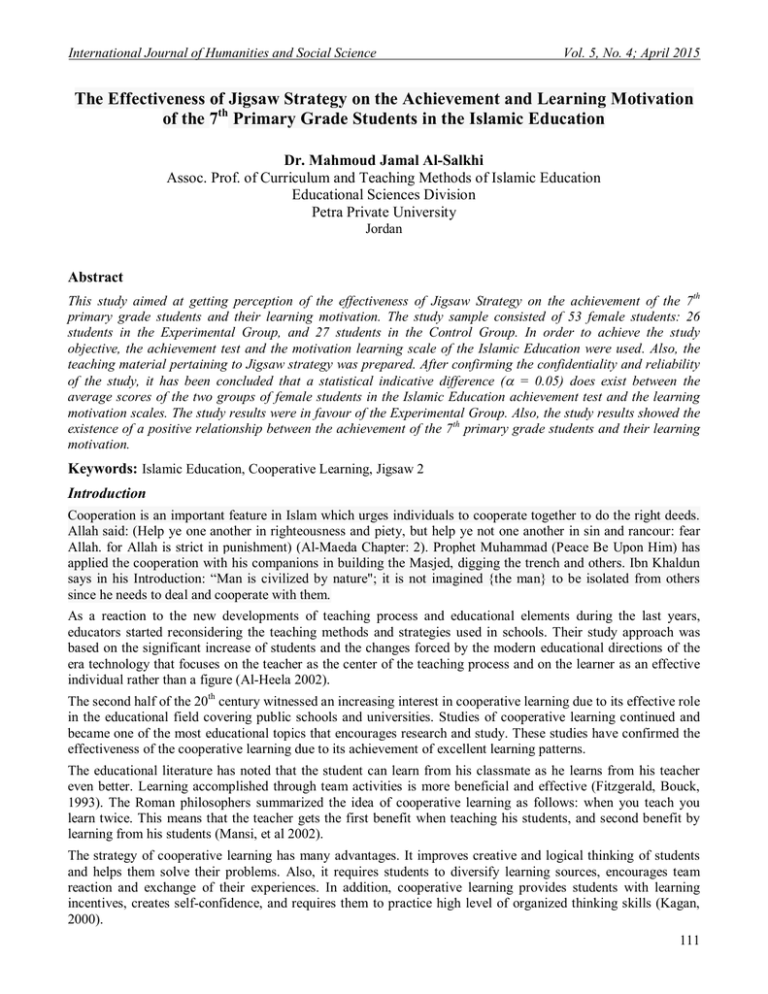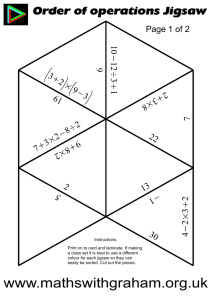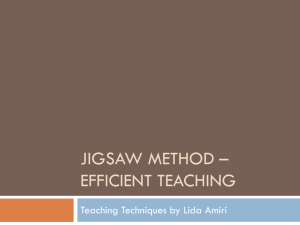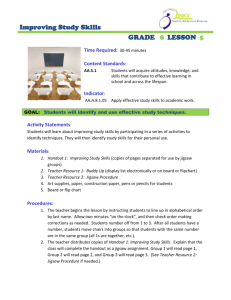The Effectiveness of Jigsaw Strategy on the Achievement and Learning... of the 7 Primary Grade Students in the Islamic Education
advertisement

International Journal of Humanities and Social Science
Vol. 5, No. 4; April 2015
The Effectiveness of Jigsaw Strategy on the Achievement and Learning Motivation
of the 7th Primary Grade Students in the Islamic Education
Dr. Mahmoud Jamal Al-Salkhi
Assoc. Prof. of Curriculum and Teaching Methods of Islamic Education
Educational Sciences Division
Petra Private University
Jordan
Abstract
This study aimed at getting perception of the effectiveness of Jigsaw Strategy on the achievement of the 7th
primary grade students and their learning motivation. The study sample consisted of 53 female students: 26
students in the Experimental Group, and 27 students in the Control Group. In order to achieve the study
objective, the achievement test and the motivation learning scale of the Islamic Education were used. Also, the
teaching material pertaining to Jigsaw strategy was prepared. After confirming the confidentiality and reliability
of the study, it has been concluded that a statistical indicative difference ( = 0.05) does exist between the
average scores of the two groups of female students in the Islamic Education achievement test and the learning
motivation scales. The study results were in favour of the Experimental Group. Also, the study results showed the
existence of a positive relationship between the achievement of the 7th primary grade students and their learning
motivation.
Keywords: Islamic Education, Cooperative Learning, Jigsaw 2
Introduction
Cooperation is an important feature in Islam which urges individuals to cooperate together to do the right deeds.
Allah said: (Help ye one another in righteousness and piety, but help ye not one another in sin and rancour: fear
Allah. for Allah is strict in punishment) (Al-Maeda Chapter: 2). Prophet Muhammad (Peace Be Upon Him) has
applied the cooperation with his companions in building the Masjed, digging the trench and others. Ibn Khaldun
says in his Introduction: “Man is civilized by nature"; it is not imagined {the man} to be isolated from others
since he needs to deal and cooperate with them.
As a reaction to the new developments of teaching process and educational elements during the last years,
educators started reconsidering the teaching methods and strategies used in schools. Their study approach was
based on the significant increase of students and the changes forced by the modern educational directions of the
era technology that focuses on the teacher as the center of the teaching process and on the learner as an effective
individual rather than a figure (Al-Heela 2002).
The second half of the 20th century witnessed an increasing interest in cooperative learning due to its effective role
in the educational field covering public schools and universities. Studies of cooperative learning continued and
became one of the most educational topics that encourages research and study. These studies have confirmed the
effectiveness of the cooperative learning due to its achievement of excellent learning patterns.
The educational literature has noted that the student can learn from his classmate as he learns from his teacher
even better. Learning accomplished through team activities is more beneficial and effective (Fitzgerald, Bouck,
1993). The Roman philosophers summarized the idea of cooperative learning as follows: when you teach you
learn twice. This means that the teacher gets the first benefit when teaching his students, and second benefit by
learning from his students (Mansi, et al 2002).
The strategy of cooperative learning has many advantages. It improves creative and logical thinking of students
and helps them solve their problems. Also, it requires students to diversify learning sources, encourages team
reaction and exchange of their experiences. In addition, cooperative learning provides students with learning
incentives, creates self-confidence, and requires them to practice high level of organized thinking skills (Kagan,
2000).
111
ISSN 2220-8488 (Print), 2221-0989 (Online)
©Center for Promoting Ideas, USA
www.ijhssnet.com
These advantages were confirmed by (Tobin, Tippins & Gallard, 1994) through their intensive reviews of
research studies regarding cooperative learning. Although cooperative learning can not solve all problems, its
value is due to the fact that it provides students the opportunity to express and defend their opinions. Also,
cooperative learning allows the student to share his ideas with his classmates and respect their points of view.
Also, the new cooperative strategy considers students the center of the learning process, and thus it develops the
individual as well as team responsibilities.
It should be noted that cooperative learning has some negatives. For example, team members might share
incorrect concepts or information in the absence of the teacher’s supervision. Also, feeling of high performer
students with superiority or low performers with frustration might create individual discrimination among team
members. Additionally, discussion of team members should be conducted in a friendly learning environment and
be carefully monitored and controlled, otherwise, teamwork would be waste of time.
Jigsaw 2 Strategy
In spite of the advantages of cooperative learning, the educators and psychology scientists working at Austin
schools in Texas state have created a developed method for cooperative learning called Jigsaw similar to the
structure of a game that carries the same name “Jigsaw”. The main purpose of this new learning method is to
develop close relationships between students of British, Spanish, and Black ethnics in order to minimize ethnic
tension.
The pioneer of Jigsaw strategy is called Arnson (1978). Later, it was developed by Slave (1980) who designed a
modified pattern of cooperative differential integration of information called (Jigsaw 2). In this strategy, students
are divided into heterogeneous groups, each group consist of 4-5 members. In this strategy, the members of each
group study the same subject, for example, a chapter in a textbook and each member concentrates on a specific
part of the subject. After that, the members of different groups assigned the same part hold a discussion meeting.
After that, each member joins his original group to explain to them what he has learned from his specific
assignment. Finally, each member takes an individual test and all member scores are used to calculate each
group’s score (Al-Salkhi, 2009).
The Jigsaw strategy 2 is considered an image of cooperative learning by which students learn through their
activities within small groups. Each member specializes in a specific portion of the study subject and then he
shares the acquired knowledge with the other members of his group. The design of Jigsaw model has three main
stages (Albaghdadi, et al, 2005):
A) Planning stage: which contains three steps
1. Purpose identification: the main purpose of Jigsaw strategy is to acquire the organized knowledge through
specialty groups. Also, the necessary behavioral objectives of each study subject need to be identified.
2. Designing study material: the teacher is responsible for preparing the study material and tools such as
textbooks, references, articles, video tapes, drawings, etc.
3. Grouping the students according to their interests, previous experience, and achievement level. However, the
group should be heterogeneous to enable low performers learn from high performers.
4. Designing evaluation tools: the teacher should prepare a test in view of the identified behavioral objectives
that cover all study subjects.
B) Implementation stage of Jigsaw 2 strategy that consists of four aspects (Table 1).
112
International Journal of Humanities and Social Science
Vol. 5, No. 4; April 2015
Table (1): The Main Aspects of the Implementation Stage of the Jigsaw 2 Strategy
Aspect
Grouping of Information
Meeting Experts
Team Reports
Assessment and Evaluation
Description
Distributing students into small groups.
Distributing subjects to individual students of each group to assume the
role of expert in the assigned unit.
Studying the subjects based on the expert reports.
Meeting of experts assigned the same unit to discuss its elements and
compare notes given by experts.
In their meeting, experts prepare a report covering the main points of the
subject to share them with their group members.
Direct the work of groups and develop their concepts.
Monitor students’ activities and get teachers involved in the group work.
Encourage students by using immediate enforcement and feedback.
C) Evaluation stage of Jigsaw 2 strategy that consists of three main levels (Table 2)
Table (2): The Three Basic Levels in the Evaluation Stage of the Jigsaw 2 Strategy
Process
Group Evaluation
Evaluation of experience
progress
Evaluation of material
comprehension
Description
Determining the work progress of groups and students’ participation in
the teamwork.
Determining the student’s progress in the experts’ group and as a member
in his group.
Giving students a written exam to determine each student’s progress in
meeting the learning objectives.
Due to the importance of cooperative learning strategies in general and Jigsaw strategy in specific, a number of
studies have been conducted. These studies aimed at realizing the effect of these strategies on the students’
achievement, thinking, motivation, etc. in different study materials and various study stages. Such studies include
(Maden, 2011) who made a comparison between Jigsaw strategy and the conventional method with regard to the
development of written expression skills. It was found that there was no significant difference between the two
methods. In Turkey, a study conducted by (KOÇ, et.al.2010) concluded that teaching Chemistry using Jigsaw
method was more effective in enhancing students’ achievement compared with the conventional method. Another
study conducted by (Mengduo, Xiaoling, 2010) tried to examine the effectiveness of using Jigsaw 2 strategy in
teaching the English language. The results showed motivation and reinforcement of students’ participation. Also,
the results of Abu-Snina (2008) study supported the results of the above study. In addition, the results of a study
conducted by (Souvignier s, Kronenberger, 2007) revealed that a group of the 3 rd primary grade students who
studied an Astronomy unit using Jigsaw 2 method showed higher performance than the control group students
who followed the conventional method.
Another study was conducted in Turkey by (GÖMLEKS˙IZ, 2007) aimed at enhancing the Engineering students’
knowledge of English language vocabulary and phonetics. The applied Jigsaw method showed positive learning
results compared with the conventional method.
Whereas, the study of Al-Hadeed (2004) aimed at comparing the effect of using the cooperative learning with that
using the conventional method in the achievement of the 9th primary grade students in the Islamic Education. In
order to support Al-Hadeed study, a random sample was selected consisting of 154 male and female students. Her
study showed the existence of a statistical indicative difference between the achievement of the experimental
group and the control group due to the learning method, and in favor of the cooperative learning.
It is noted that previous studies focused on teaching Islamic Education using the normal cooperative method.
Whereas, the present study emphasized the Jigsaw strategy in teaching the Islamic Education and investigating its
effect on the learning achievement and motivation, and trying to find a correlation between them.
113
ISSN 2220-8488 (Print), 2221-0989 (Online)
©Center for Promoting Ideas, USA
www.ijhssnet.com
Statement of the Problem
The study problem emerges from the keen interest of the researcher and his critical need for a strategy in which
the learner has an effective role in the learning process which focused on his achievement and motivation. The
researcher believes that Jigsaw 2 strategy satisfies this need. This problem can be formulated in the following
main question: What is the effect of using Jigsaw Strategy on the achievement of the 7th primary grade students
and their learning motivation? From the previous question, the following sub-questions arise:
1st Question: Is there any statistical indicative difference ( = 0.05) between the average achievement test scores
of the female students in the Experimental Group and Control Group attributed to the teaching strategy (Jigsaw
vs.Conventional)?
2nd Question: Is there any statistical indicative difference ( = 0.05) between the average motivation scores of the
female students in the Experimental Group and Control Group attributed to the teaching strategy (Jigsaw
vs.Conventional)?
3rd Question: Is there any statistical indicative correlation at level ( = 0.05) between the learning achievement
and motivation of the female students of the 7th grade?
Objectives of the Study
The present study aimed at meeting the following objectives:
1- Get knowledgeable of the effectiveness of Jigsaw strategy in teaching the Islamic Education to the 7th primary
grade students.
2- Discover any differences in the achievement of the 7th primary grade students in the Islamic Education
attributed to the teaching strategy.
3- Discover any differences in the motivation level attributed to the teaching strategy.
4- Discover if there is any correlation between achievement and motivation in learning the Islamic Education
course.
Significance of the Study
The significance of the current study comes from the following:
1- This study is distinguished by its genuineness as it is the first time this research is conducted in Jordan.
2- It helps teachers and supervisors get familiar with Jigsaw 2 strategy for possible application, if proved
effective.
Limitations of the Study
- This study is applied only on the female students of the 7th primary grade at the Universal Schools in Amman,
Jordan.
- The study is limited to the 5th unit of Islamic Fiqh in the second part of the Islamic Education textbook. This unit
is part of the curriculum of the 7th primary grade for the scholastic year 2013/2014.
Methodology of the Study
In this study, the researcher used a semi-empirical procedure to investigate the effectiveness of Jigsaw strategy in
the achievement and motivation of female students of the 7th primary grade in the Islamic Education course.
Study Sample
A sample of (53) female students of the 7th primary grade was intentionally selected from the Universal Schools in
Amman, Jordan due to the cooperation and interest of the school administration and the teacher of the Islamic
Education course in applying this experiment. The sample was distributed into two groups. The first one consisted
of (27) female students and was considered an Experimental group that used Jigsaw 2 strategy. The second one
consisted of (26) female students and was considered a Control group that followed the conventional method.
114
International Journal of Humanities and Social Science
Vol. 5, No. 4; April 2015
Study Tools
*Teaching by Jigsaw
The study material taught by the Jigsaw Strategy was prepared according to the following schedule:
- Lesson Identification: the researcher has chosen lessons from the 7th grade Islamic Education book/Islamic Fiqh
Unit/Second Semester.
- Identification of the requirements of the learning process and the appropriate class atmosphere.
- Preparation of a lesson plan to identify the teacher/learner role based on Jisgaw Strategy, and to train the
students using the cooperative learning.
Achievement Test: It was designed to measure the achievement of the female students of the 7th prime grade in
the Islamic Fiqh unit. The purpose of this test is to compare the effectiveness of using the Jigsaw strategy 2 with
that of the conventional method.
The content of the Fiqh unit was analyzed, and the behavioral objectives were identified and formulated to cover
all aspects of the unit content according to the Bloom classification. After that, the specification table was
prepared, and the multiple choice test items (20) were formulated objectively. It was taken into account that the
test includes items that measure the behavioral objectives at three levels (knowledge, comprehension & upper
mental levels). To confirm the credibility of the test, its items were reviewed by a number of faculty members at
Petra University and the supervisors of the Islamic Education course. Also, consistency coefficient was calculated
using the formula of Codar Ritchardson (KR 20) and found to be (0.91) which was suitable for the purpose of this
study. Additionally, the difficulty coefficient was also calculated for each test item, and the results were in the
range of (0.19-0.82). The discrimination coefficient was also calculated for each test item, and the results were in
the range of (0.27-0.30) which is considered acceptable for the purpose of this study.
Measure of Motivation to Learn Islamic Education
The researcher developed a measure and wrote its items by referring to the educational literature with regard to
the learning motivation, and reviewing some motivation measures. Finally, the measure was formed of 30 items.
Its credibility was confirmed by referees of psychology, and its consistency was calculated as (0.93) using the
formula of Cronbach Alfa.
Study Procedure
The study was carried out according to the following steps:
1) Preparing the teaching material used for the two study groups.
2) Applying Jigsaw strategy on the experimental group prior to the execution of the experiment by teaching
three lessons of the unit previous to Al-Fiqh unit.This will give the students the opportunity to get familiar
with the new strategy.
3) Preparing both pre-test and post-test as well as the motivation measure to determine the students’
achievement and motivation to learn the Islamic Education.
4) Following up by the researcher on the teachers’ classroom activities for both groups.
5) Applying the pre-test and post-test on the experimental and control groups.
6) Teaching the experimental group using Jigsaw strategy.
7) Teaching the control group using the conventional method.
Study Design
Independent variables: have two levels A) Jigsaw Strategy B) Conventional Strategy
Dependent variables: have two levels A) Learning Achievement in the unit of Islamic Fiqh
B) Motivation to learn Islamic Education
Statistical Treatment
The statistical package for the social sciences (SPSS) was used in analyzing the study results.
The following statistical treatments were used: Arithmetic Means, Standard Deviations, Formula of Codar
Ritchardson (KR 20), Formula of Cronbach Alfa, ANCOVA, and Person Coefficient.
115
ISSN 2220-8488 (Print), 2221-0989 (Online)
©Center for Promoting Ideas, USA
www.ijhssnet.com
Study Results and Discussions
The results of the 1st question that states: Is there any statistical indicative difference ( = 0.05) between the
average post-achievement test scores of the female students in the Experimental and Control Groups attributed to
the teaching strategy (Jigsaw vs. Conventional)? To answer this question, the Arithmetic Means and Standard
Deviations of the pre-achievement and post-achievement test scores of both groups have been calculated as shown
below:
Table (3): Arithmetic Means and Standard Deviations in the pre and Post Tests for the Two Study Groups
Test
Pre-Test
Post-Test
Experimental
Arithmetic
Mean
9.21
16.74
Group
Standard
Deviation
11.12
12.58
Control
Arithmetic
Mean
8.13
12.29
Group
Standard
Deviation
13.66
11.78
The above table shows that the Arithmetic Means of the scores of the two groups in the post-achievement test are
(16.74 & 12.29). This indicates an apparent difference between the Arithmetic Means of the two groups. In order
to explain this difference, the individual contrasts (ANCOVA) was used, and the next table shows the analysis
results.
Table (4): Results (ANCOVA) for Female Student’s Grades in Post test Achievement for the two Study
Groups
Contrast
Source
Pre-Test
Teaching
Method
Error
Total
Sum of
Squares
472.51
7285.4
Free
Scores
1
1
Mean of
Squares
472.51
7285.4
13911.557
21498.833
51
53
201.616
F
2.31
25.672
Indication
Level
0.332
0.000
Function at indication level ( = 0.05)
The above table shows statistical indicative differences in the Arithmetic Means of the post-achievement test
scores of the two female groups. These differences are mainly due to the teaching strategy (Jigsaw vs
Conventional) and are in favor of the Experimental group who studied through Jigsaw strategy. These results are
attributed to the new learning environment provided by Jigsaw method that helps students develop their
knowledge based on a variety of resources such as: library, Internet, and computer. Such resources are not made
available through the conventional method. In addition, Jigsaw emphasizes the interaction between the individual
students of the heterogeneous group which is usually followed by discussions between the members of the same
group. Therefore, Jigsaw 2 strategy has a great effect on understanding the study material. Also, this strategy
helps high achievers to communicate knowledge to low achievers. These results agree with the study results of
Al-Hadded (2004), Abu-Snina (2008), Souvignier & Kronenberger (2007), Mengduo & Xiaoling (2010), KOÇ,
et.al (2010) and Gomleks˙IZ,2007 (2007). Whereas, Maden (2011) does not agree with these results.
The results of the 2nd question that states: Is there any statistical indicative difference ( = 0.05) between the
average motivation of the female students of the experimental group and those of the control group to learn the
Islamic Education which could be attributed to the teaching strategy (Jigsaw vs Conventional)? To answer this
question, the Arithmetic Means and Standard Deviations of the motivation scores of both groups have been
calculated (Table5).
116
International Journal of Humanities and Social Science
Vol. 5, No. 4; April 2015
Table (5): Arithmetic Means and Standard Deviations of the Motivation Measures to learn Islamic
Education for the two Study Groups
Test
Pre-Test
Post-Test
Experimental Group
Arithmetic Mean
Standard Deviation
2.22
3.98
Control Group
Arithmetic Mean
Standard Deviation
0.601
0.712
2.14
1.87
0.553
0.496
Table (5) shows the Arithmetic Means of the post-motivation test scores of the two groups as (3.98 & 1.87). This
indicates a clear difference between the two Arithmetic Means of the two groups. To investigate the statistical
indicative difference between the two Arithmetic Means, the analysis of the individual contrasts (ANCOVA) was
applied as shown in Table (6).
Table (6): Results of Analysis of (ANCOVA) for Female Students’ Grades on a Scale of Motivation to
Learn Islamic Education for the two Study Groups
Contrast Source
Pre-Test
Teaching Method
Error
Total
Sum of
Squares
0.200
27.339
21.195
48.612
Free Scores
1
1
51
53
Mean of
Squares
0.200
27.339
0.307
F
Indication Level
0.470
67.493
0.236
0.001
Function at the indication level ( = 0.05)
The above table shows statistical indicative differences in the Arithmetic Means of motivation scores of the two
groups in learning the Islamic Education. These differences are mainly due to the teaching strategy (Jigsaw vs
Conventional) and are in favor of the experimental group who studied through Jigsaw strategy. Also, this strategy
promoted female students’ activities and motivation to learn the Islamic Education. Also, it enforced their selfconfidence and enhanced their achievements. This conclusion agrees with the study results of Kagan (2000) and
(Mengdue& Xiaoling (2010).
The result of the3rd Question that states: Is there any correlation that has statistical indication at the level ( =
0.05) between the learning achievement and motivation of the 7th primary grade to learn Islamic Education? To
answer this question, the correlation coefficient of Person was used to find if there is any linkage between the
scores of the 7th grade female students in the post-achievement test and their motivation scores in learning Islamic
Education as illustrated in the following (Table 7):
Table (7): Pearson Correlation Coefficient between Academic Achievement and Motivation to Learn
Islamic Education
Learning
Arithmetic
Mean
14.81
Achievement
Standard
Deviation
17.181
Learning
Arithmetic
Mean
2.91
Motivation
Standard
Deviation
0.924
“R” Value
Indication
0.488
0.001
Function at the indication level ( = 0.05)
The above table shows a positive value (0.488) of Person’s correlation coefficient. This value indicates a positive
correlation between learning achievement and learning motivation. This result can be explained by the fact that
Jigsaw 2 is proved to be effective in promoting learning motivation which leads to increasing learning
achievement.
Recommendations
In view of the study results, the researcher recommends the following:
Conducting more studies aiming at discovering the effect of Jigsaw 2 strategy in learning variables other than
achievement and motivation such as self-esteem, test anxiety, and classroom interaction.
117
ISSN 2220-8488 (Print), 2221-0989 (Online)
©Center for Promoting Ideas, USA
www.ijhssnet.com
Adopting Jigsaw 2 strategy in teaching the Islamic Education due to its effectiveness in enhancing both
achievement and motivation.
Conducting training sessions for the teachers of Islamic Education to be well trained in using Jigsaw 2 strategy.
References
Abu snina, O. (2008). the effect of two forms of cooperative learning and students’ gender on the immediate and
delayed achievement of tenth grade students in National and Civic Education in comparison with the
traditional method of learning. Al-Quds Open University Journal for Research and Studies, 14, 85-111.
Albaghdadi, M., Abu alhuda,H., Kamal,A.(2005). Cooperative learning. Alfikr Alarabi Publishing and
Distribution, Cairo.
Alhadeed, F. (2004).The Impact of Cooperative learning in Islamic education and its impact on the Achievement
of ninth grade students compared to the Conventional Method. Unpublished MA Thesis, University of El
Fasher, Sudan.
AL-Heela, M. (2002). Classroom teaching skills, Almassira Publishing and Distribution, Amman.
Alsalkhi,M.(2009). Methods of teaching Islamic education. , Alkonouz Publishing and Distribution, Amman.
Fitzgerald, W.; Bouck, M., (1993).Models of Instruction. In Research Ideas for the Classroom Middle
Mathematics (edited by Owens, D.)Macmillan Pub. Company.
GÖMLEKS˙IZ, M. N.(2007). Effectiveness of cooperative learning (jigsaw II) method in teaching English as a
foreign language to engineering students (Case of Firat University, Turkey), European Journal of
Engineering Education Vol. 32, No. 5, 613–625.
Kagan, S. (2000). The Structural Approach to Cooperative Learning In Cooperative Learning: A Response to
Linguistic and Cultural Diversity, Edited by Daniel Holt. Mc Henry Ill, and Washington, D.C: Delta
System and center for Applied Linguistics, 9-19.
KOÇ, Y , DOYMUŞ , K. KARAÇÖP, A , ŞİMŞEK, Ü(2010) The Effects of Two Cooperative Learning
Strategies on the Teaching and Learning of the Topics of Chemical Kinetics , Journal of Turkish Science
Education, Volume 7, Issue 2, 52-65.
Maden, S. (2011). Effect of Jigsaw I Technique on Achievement in Written Expression Skill, Educational
Sciences: Theory & Practice - 11(2), 911-917
Mengduo, Q & Xiaoling, J. (2010). Jigsaw Strategy as a Cooperative Learning Technique: Focusing on the
Language Learners. Chinese Journal of Applied Linguistics, Vol. 33 No. 4. 113-125.
Muncie, M, Saleh, A, Qasim, N and Aljundi, A. (2002). Educational psychology and individual differences of the
children, The Alexandria Center for the Book. Alexandria.
Souvignier, E., & Kronenberger, J.(2007). Cooperative learning in third graders’ jigsaw groups for mathematics
and science with and without questioning training. British Journal of Educational Psychology, 77, 755–
771.
Tobin,K., Tippins, D., Gallard, A(1994). Research on instructional strategies for teaching science, Handbook of
research on science teaching and learning, V.45. 45-93.
118







